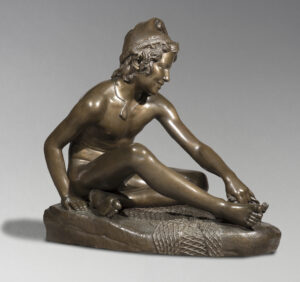François RUDE
(1784-1855)
Renowned for having carried out La Marseillaise, one of the four high-reliefs of the Arc de Triomphe on the Place de l’Etoile in Paris (1836), François Rude’s work is particularly noteworthy for his innovative insight in the field of sculpture, which was in full revival during the first half of the 19th century. While freeing himself from the academicism and distinguishing himself from the exacerbated expressionism brought to light in the emerging Romantic movement, he paved his own way by introducing in his work a quest of naturalism.
Trained in drawing and modelling in Dijon, he arrived in Paris in 1807 and entered the École des Beaux-Arts in 1809. Although he won the Premier Prix de Rome in 1812, instead of going to Italy, Rude left for Belgium where he stayed from 1815 to 1827 together with his patron, Louis Frémiet, great-uncle of the sculptor, Emmanuel Fremiet. He there received a few official commissions for the scenery and decoration of the Théâtre Royal in Brussels and of the Palais de Tervueren. On his return to Paris, he exhibited at the Salon, but it was not until 1833 that he fully gained recognition with his Neapolitan Young Fisherman Playing with a Turtle, more than twenty years after his receiving the Prix de Rome. He was rewarded with the Légion d’honneur and his marble sculpture was bought by the State (currently kept in the Musée du Louvre). From then on, public commissions poured in, including that for the scenery of the Arc de Triomphe.
Many of his artworks are held in French public collections. A museum is even dedicated to him in Dijon, his birthplace.
François Rude’s influence was considerable, particularly among his pupils: Emmanuel Fremiet and above all Jean-Baptiste Carpeaux, who paid him numerous sculpted tributes. Doesn’t his Fisherman with a Shell derive directly from the Neapolitan Fisherman with a Turtle?

